From robins and mistletoes to our traditional Christmas tree, many symbols associated with the festive time have been taken from nature. Here are to name just a few...
The Nature of Christmas
© Anne Nygård on Unsplash
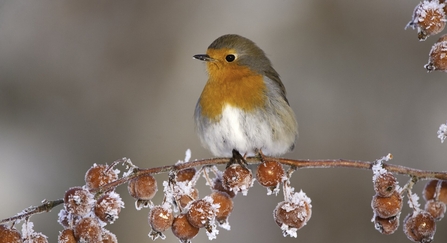
Robin in snow © Mark Hamblin/2020VISION
Robins can be found in parks, scrub and woodland and have a loud territorial song that they sing from prominent perches through the winter. Male and females have their own territories and only call a truce during breeding season when the female is allowed into the male’s territory where she sets up a nest. There are many myths surrounding the UK’s favourite bird and how it has become associated with Christmas. Some relate to Bible stories including the kind-hearted robin who got its red breast tending to baby Jesus’ fire. Others equate the robin’s red breast to the red uniforms of Victorian postmen who brought Christmas cards. Whatever the reason, robins have become synonymous with Christmas.
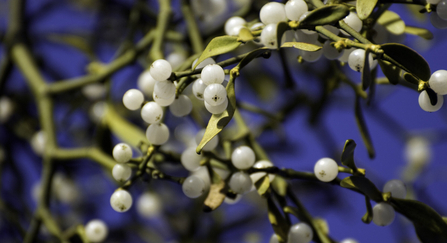
Mistletoe © Zsuzsanna Bird
Mistletoe was a symbol of love and friendship in Norse mythology. In Britain, the custom of kissing under the mistletoe developed, with a berry picked from the sprig before a kiss – when all the berries were gone, there could be no more kissing. The plant itself is actually less romantic – mistletoe is a parasite and attaches itself to a tree and then grows out of the branch. Mistletoe is often covered in bird poo and its name literally translates as ‘poo on a stick’ from the Anglo Saxon ‘mistel’ meaning dung and ‘tan’ meaning twig, or stick.
The mistle thrush, a large songbird, found in parks, gardens and woodland, gets its common name from its love of mistletoe. It enjoys the sticky berries and, once it has found a berry-laden tree, will guard it from any would-be thieves. It also helps mistletoe to thrive by wiping its bill on the tree bark to remove sticky residue and accidentally ‘planting’ the seeds in weak spots.
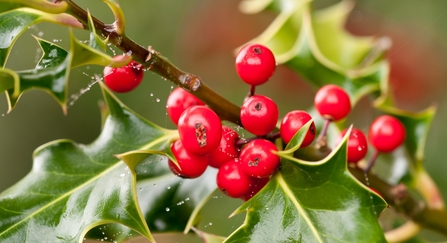
Holly berries © Ross Hoddinott/2020VISION
Found in a variety of habitats from woodland to gardens, holly berries are an important food source for lots of birds including redwings and fieldfares. Holly was used at the Winter Solstice to ward off evil spirits and
celebrate new growth. In Christian symbolism, the prickly leaves represent the crown of thorns that Jesus wore when he was crucified. The berries represent the drops of blood that were shed by Jesus because of the thorns; in Scandinavia, holly is known as the Christ Thorn.
Christmas tree
Over the years the evergreen fir tree has become the traditional tree of choice for people to celebrate winter.
Christians saw it as a sign of everlasting life with God, Romans used fir trees to decorate their temples at the festival of Saturnalia, whilst Pagans used branches of it to decorate their homes during the winter solstice as a symbol of the spring to come. Across many parts of northern Europe, cherry or hawthorn plants were
used as alternative Christmas trees. The plants were put into pots and brought inside in the hope that they would flower at Christmas time.
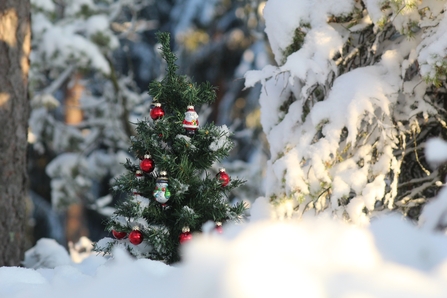
© Anne Nygård on Unsplash
Bring nature inside
Ditch the plastic decorations and use natural materials from your garden or nearby wild patch. Look out for twigs, pine cones, leaves and ivy or holly sprigs – when out foraging, please take only as much as you need and make sure you leave plenty for wildlife.
Use the small twigs to design star patterns for decoration. You can attach pine cones together in a garland or paint them green to look like a Christmas tree. Dried oranges make for a fragrant eyecatcher hanging over the mantlepiece – simply slice them and bake at around 65 degrees in the oven for a few hours (turning occasionally).
Discover more ideas for a sustainable Christmas here.
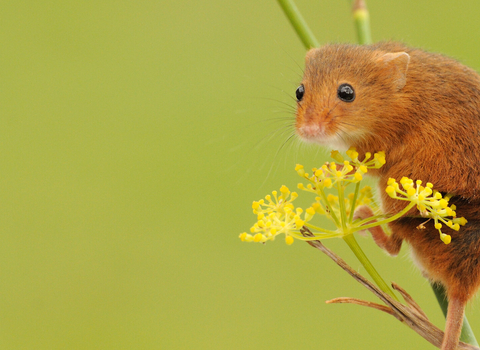
Harvest mouse © Amy Lewis
Wildlife Christmas presents
Support your local Wildlife Trust and help protect wildlife all the while making that wildlife lover in your life happy.

